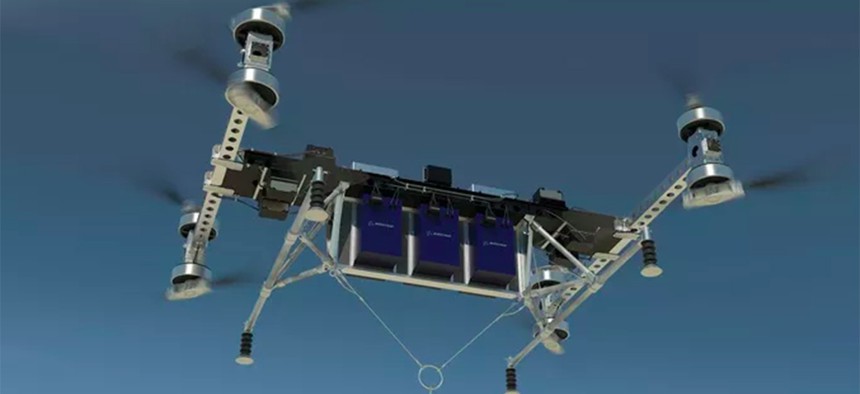Tomorrow’s Cargo Drones Won’t Look Much Like Today’s Helicopters

Boeing
Boeing unveils a squarish, skeletal quadcopter to try out new unmanned-delivery concepts.
Boeing’s newest prototype drone is a skeletal, squarish quadrotor built as a “flying test bed to mature the building blocks of autonomous technology for future applications,” the aircraft maker said in a statement.
Measuring 15 feet wide and 18 long, the Cargo Air Vehicle represents Boeing’s next step in its quest for next-generation vertical-takeoff-and-landing drones. Last year, the company acquired Aurora Flight Sciences, one year after the Virginia-based company established itself as one of the most interesting in the field by winning DARPA’s VTOL X-Plane competition.
The U.S. military, of course, has a growing interest in unmanned cargo delivery. From 2011 to 2014, U.S. forces in Afghanistan flew an experimental K-MAX helicopter on thousands of remotely-piloted supply missions there. In December, the Office of Naval Research, or ONR, wrapped a three-year series of demonstrations of its Autonomous Aerial Cargo/Utility System. It’s basically a self-piloting kit including electro-optical, infrared, and light emitting, distance and ranging (LIDAR) sensors, as well as an optical camera, that can turn any helicopter into an autonomous drone. Just hit a few buttons on the tablet PC and the bird fetches you your material.
The CAV’s virtue isn’t raw strength; its 500-pound payload is one-twelfth that of the K-Max. But sending expensive military helicopters on dangerous resupply missions, even when they aren’t manned, isn’t the best solution if the cargo to be delivered is relatively small. That’s where next-generation delivery drone designs come in.
Also, the computers on older helicopters can’t handle some of the more interesting elevation data that can be used to better guide autonomous aircraft. “We have elevation data that’s more precise” than the set used by older helicopters like the Apache, sometimes abbreviated DTED, Matt Baldwin said at a 2016 Defense Oneevent on future helicopters.
“We can put DTED on the systems now. However, DTED is old,” said Baldwin, a Joint Aviation Systems Integrator at the National Geospatial-Intelligence Agency. “I can provide you a better data set that’s more precise. If we’re talking about autonomous systems, we need very precise elevation data.”
That’s one reason why the future of unmanned rotary-wing airlift is new designs, not retrofitted older aircraft. It’s also one more reason why future delivery drones likely won’t look like the what’s touching down today.






